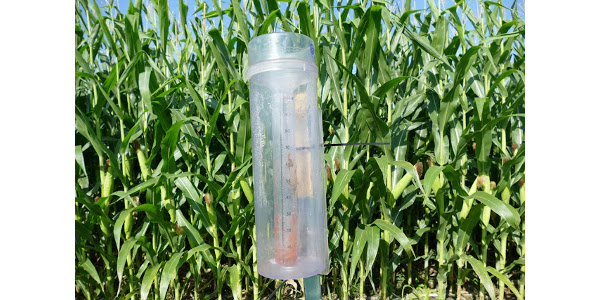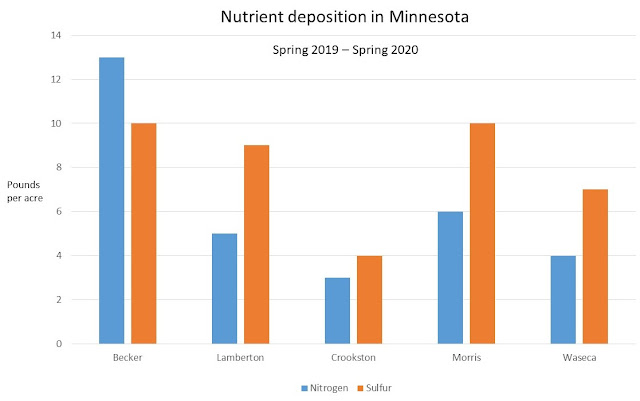What does it mean for Minnesota crops?
MINNEAPOLIS — In certain parts of Minnesota, recent research has shown that less nitrogen (N) fertilizer is needed in order to achieve an economically-optimal rate for corn. One possible explanation is that more N is falling on fields in rain and snowfall and being stored in the soil for the crop to use.
To test this hypothesis, University of Minnesota researchers installed rain gauges and snow collection stations at five locations across the state: Crookston, Morris, Becker, Lamberton, and Waseca. Sampling began in spring 2019 and has been collected continuously since then.
The study is ongoing but preliminary results from the first year of data indicate that between eight and 12 pounds of N per acre fell on Minnesota fields, with most of that coming in the spring and early summer. This is higher than the National Oceanic and Atmospheric Administration’s (NOAA) data, which estimates that six to eight pounds of N are deposited annually.
While the study’s numbers are slightly higher than NOAA’s data, they likely aren’t enough to make a meaningful difference when it comes to Minnesota farmers’ N management practices, according to Paulo Pagliari, University of Minnesota Extension soil fertility specialist and lead researcher on the project.
“We saw a bit more than what NOAA reports,” he said. “But when you look at the amount, it’s only about four pounds or so per acre more.”
Additionally, if more N is falling from the atmosphere over time, these changes should show up in Minnesota’s N rate guidelines, which incorporate environmental variables and are updated often with new field data.
Pagliari does find the regional differences interesting and is looking forward to exploring where the N is coming from as the study continues.
In the first year, the Becker site in the Central Sands region had the highest level (12 lbs/acre) while Crookston, in northwest Minnesota, had the lowest level (eight lbs/acre). Pagliari speculates that the amount of livestock and corn in each area may help explain these differences. For example, the Crookston area has fewer livestock operations and cornfields, a crop that requires high levels of N fertilizer, than the Becker area. Manure and fertilizer applied on fields can volatilize into the atmosphere and then fall back down later in a different place.
Sulfur deposition falling fast
The study also looks at sulfur (S) deposition, which has dropped dramatically in recent years due to stricter regulation of power plant emissions. A 2019 study found that S emissions in North America have decreased by 70-80% since 1990. Now, most Minnesota corn farmers apply S fertilizer, something they didn’t used to have to do due to S deposition.
Five to 10 pounds of S per acre fell in rain and snow over the course of the first year of the study.
Rain, rain, and more rain
2019 was a record wet year across many parts of Minnesota, and the state is trending wetter. Another component of the study looks at the relationship between rainfall amount and nutrient deposition. Does more rainfall mean more N is falling on fields? According to their data, light showers actually had higher N concentrations than heavy downpours. However, that isn’t the whole story.
“This has to do with dilution,” Pagliari explained. “If you get a low rainfall amount, then you get a high concentrated amount of N in the rain. But then with the higher rainfall amounts, you’re going to get a more diluted sample.”
Soil and rainfall pH
One surprising finding from year one of the study was that the pH of the rain and snow they collected was about one point higher than what NOAA reports for the state.
“It is very alkaline,” said Pagliari. “And we don’t know why.”
This could be important because alkaline precipitation may make the soil less acidic, potentially slowing down soil weathering. Soils with a pH between 6 and 7 provide the most adequate amount of nutrients. In contrast, acidic soils tend to have lower nutrient availability (for example, phosphorus) and have increased availability of toxic elements such as aluminum. Further investigation is needed to assess the impacts of alkaline rainfall on agricultural soils in Minnesota, says Pagliari.
In year two of the study, which is funded by Minnesota’s fertilizer check-off dollars through the Agricultural Fertilizer Research and Education Council (AFREC), the team will search for the culprit by measuring other nutrients, in addition to N and S.
“We’re going to look for other nutrients that are known to be sources of alkalinity, such as potassium, calcium, magnesium, and aluminum,” said Pagliari.
Pagliari is looking forward to continuing the study to get more data to back up these initial findings and explore some of the questions the data have conjured up so far.
“It will be good to see what happens on a year-to-year basis.”
Last modified: 09/02/2020














